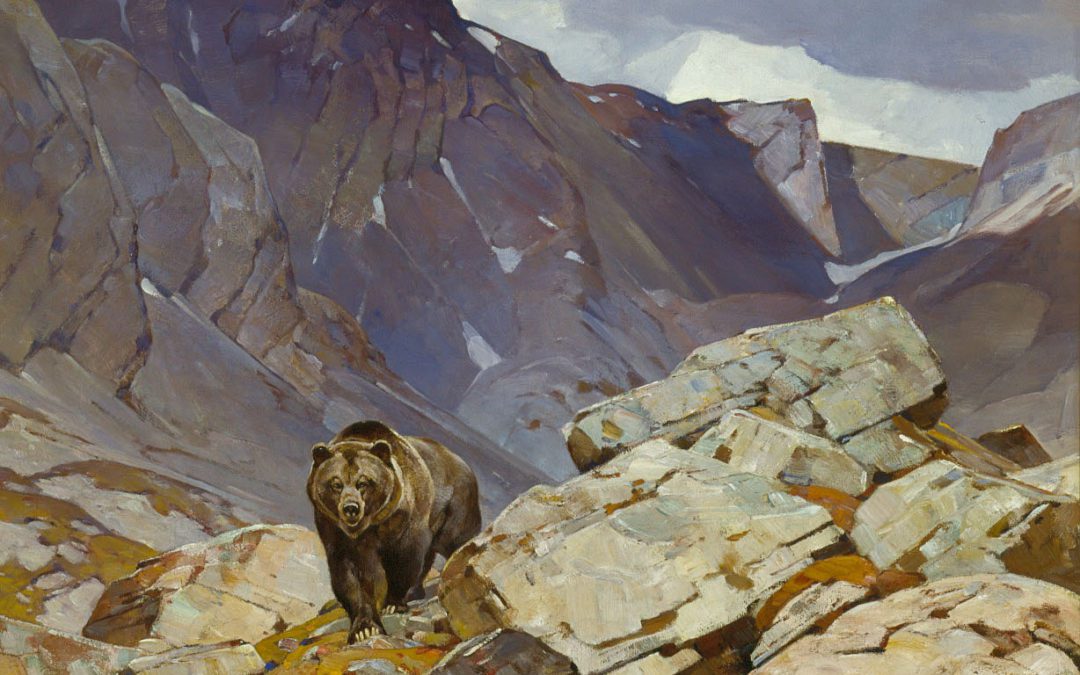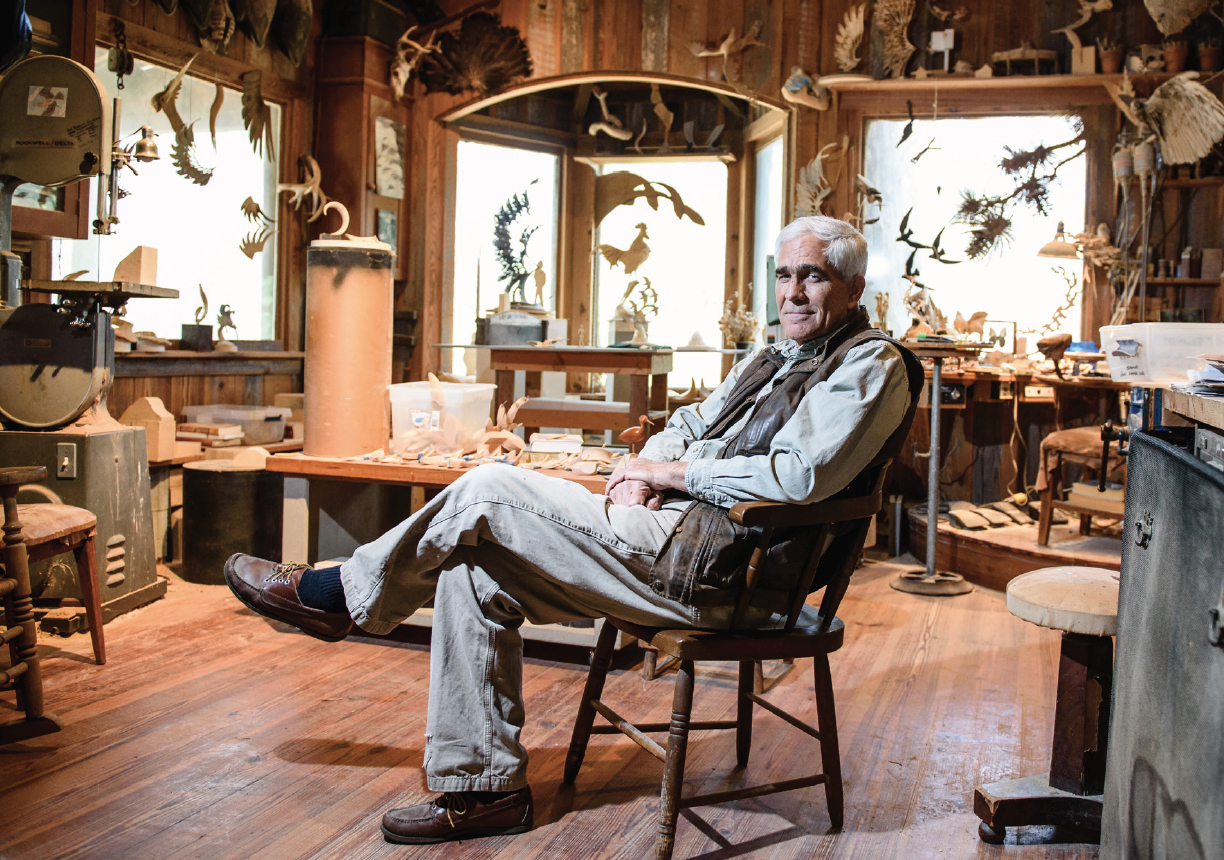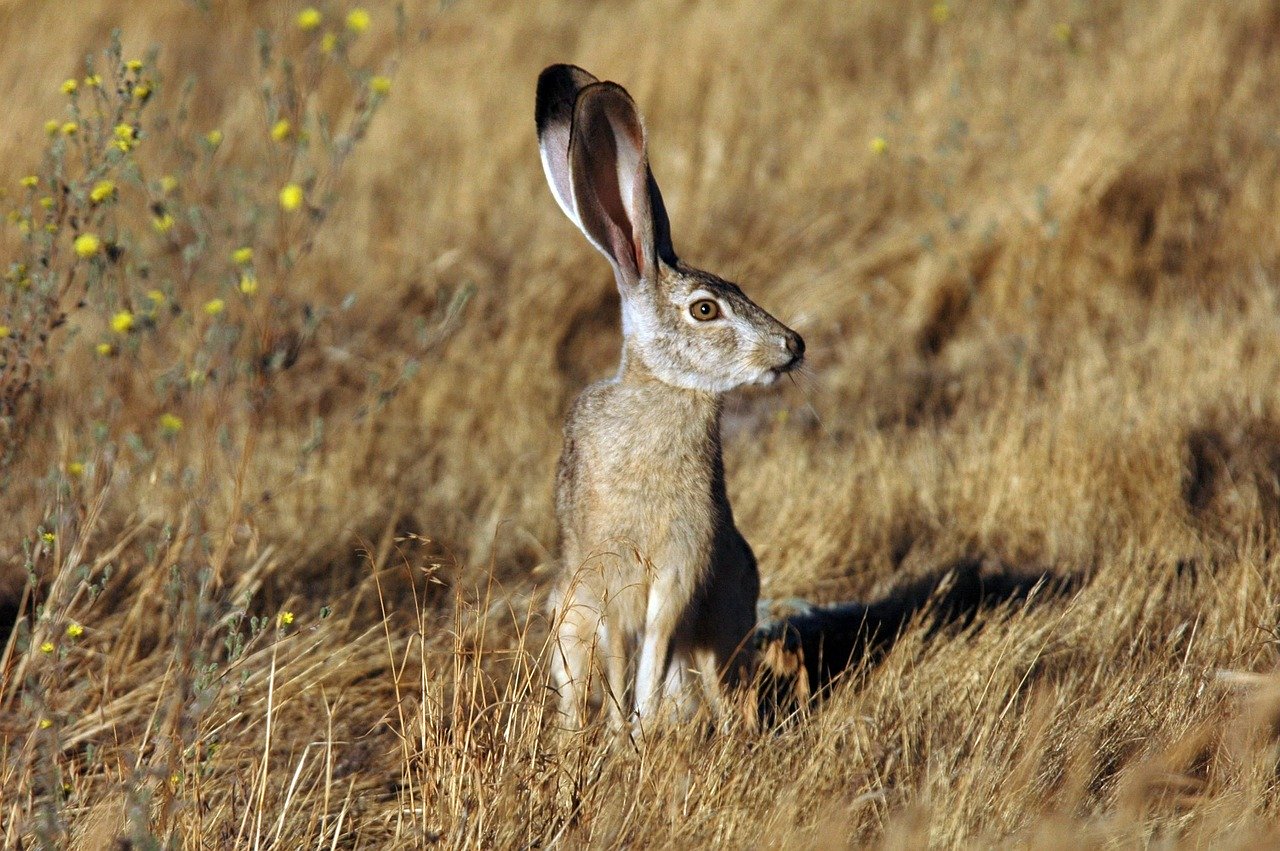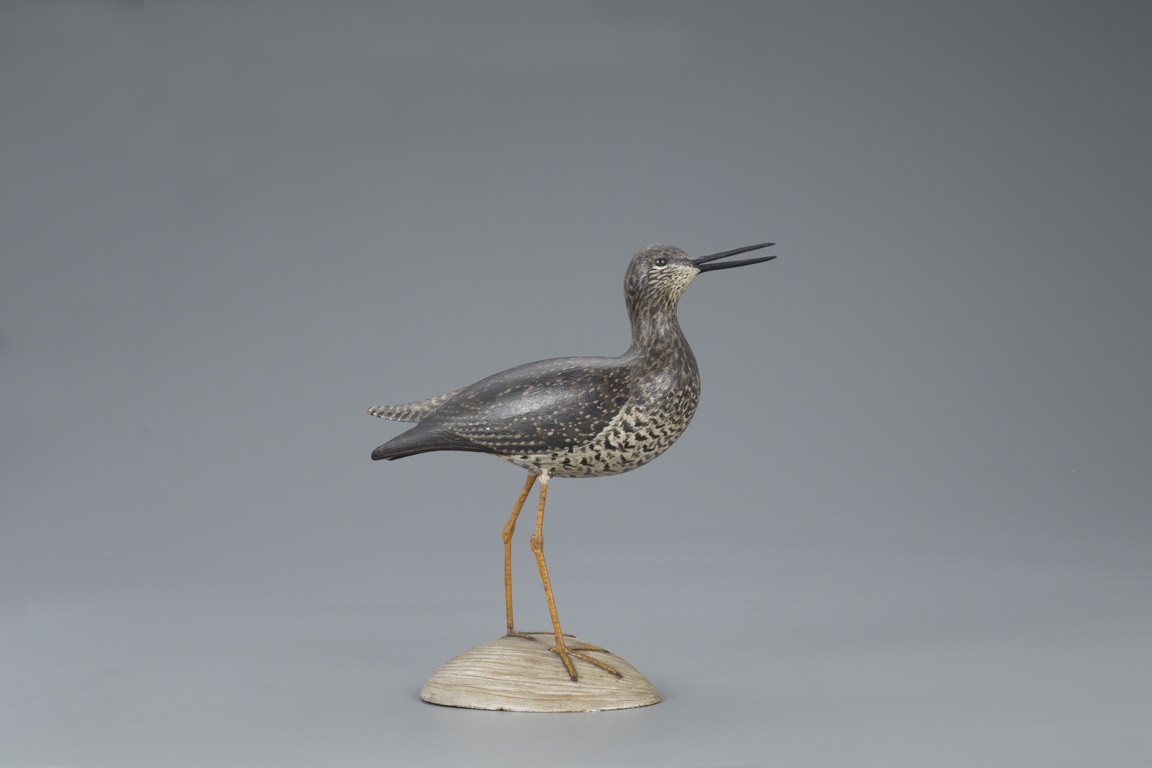![Carl Rungius at his easel in Green Point, Long Island, New York [ca. 1900]. Credit: Glenbow Archives](https://sportingclassicsdaily.com/wp-content/uploads/2019/10/sporting-classics-sportinglife-20191.jpg)
Carl Rungius at his easel in Green Point,
Long Island, New York [ca. 1900].
Credit: Glenbow Archives
Pick virtually any favorite sporting artist, painter or sculptor, and they are likely to express effusive praise for Rungius as an influence, inspiration and standard bearer.
This past summer, Rungius’ superior talent was highlighted in all its glory with a 150th birthday celebration and retrospective at the National Museum of Wildlife Art in Jackson Hole, Wyoming.
Along with his colleagues, Dr. Adam Duncan Harris, the Joffa Kerr chief curator at the museum, assembled the dual Rungius exhibition after years of planning. Harris is hopeful the presentation will provide the perfect opportunity to reflect on the role that fine art plays in heightening societal awareness about modern conservation and the human relationship with the natural world.
“Arriving at the sesquicentennial of an artist’s birth brings an extra level of significance, especially since Rungius’ reputation and his stature continue to grow,” says Harris.
Rungius (1869-1959) started his career before the advent of autos, telephones, airplanes and radio. He lived through the Great Depression, two world wars, met, befriended and delivered a moose painting to Theodore Roosevelt, encountered the last gasp of the American frontier and encountered Wyoming in her nascent beginnings of statehood. He rode with real cowboys along the flanks of the Wind River Range and later, set up a studio in Banff, gateway to the Canadian Rockies. He commuted there seasonally by train from New York City.
For wildlife art historians, the German-American Rungius is grouped among the “Big 4,” which includes Swede Bruno Liljefors and two other Germans, Wilhelm Kuhnert and Richard Friese (Rungius’ original inspiration). The National Museum of Wildlife Art has major works by every member of this esteemed quartet.
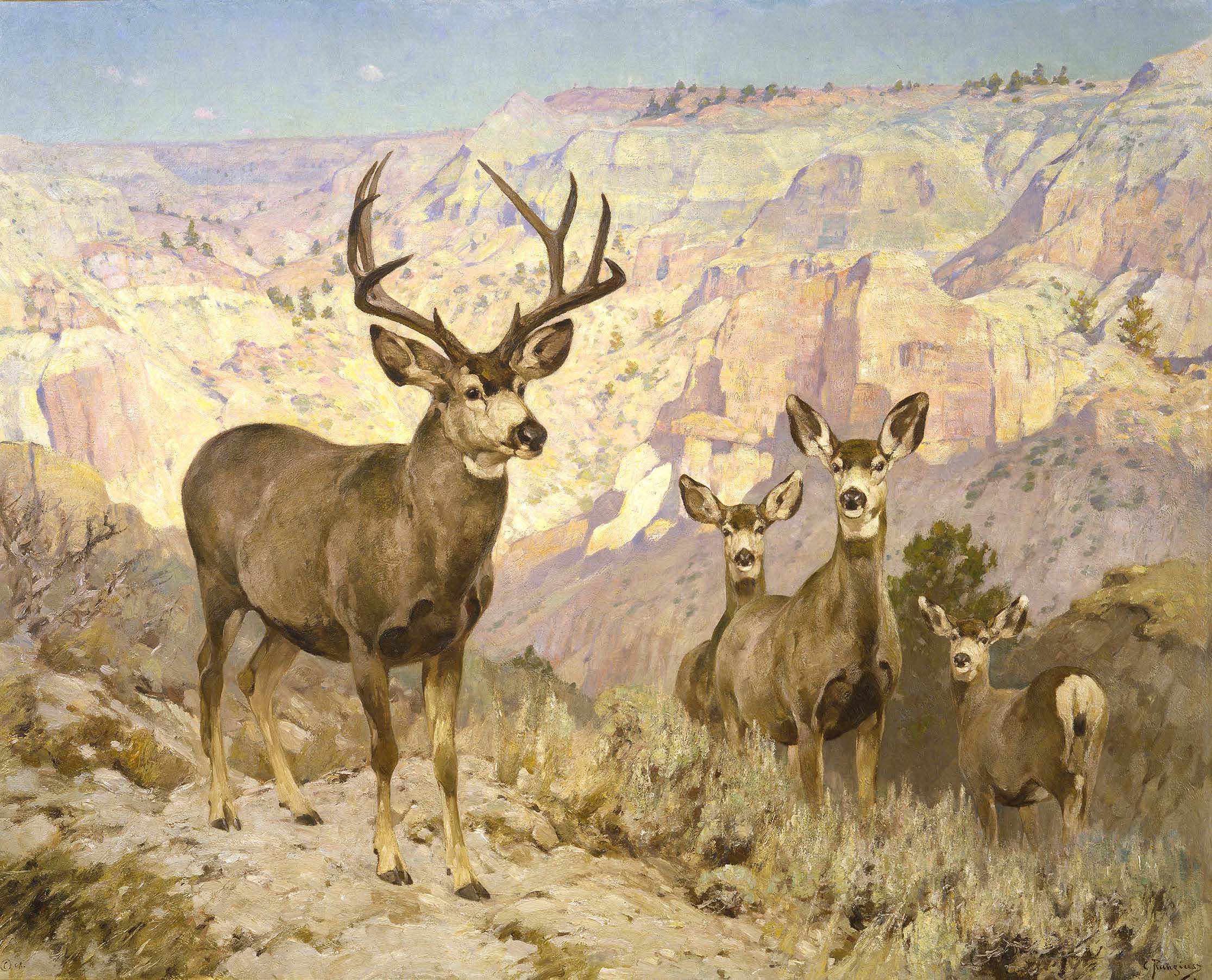
Mule Deer in the Badlands, Dawson County, Montana, 1914. Carl Rungius. Oil on canvas, 59 x 75 inches. Buffalo Bill Center of the West, Cody, WY. Gift of Jackson Hole Preserve, Inc. 16.93.2
“Rungius and Liljefors had the most ongoing exposure to their chosen subjects in the wild,” Harris notes. “Liljefors painted what was around him, especially birds of prey, in Sweden. Rungius, adopting North America as his home, spent every summer out in the wilderness, seeing animals living their lives as they did.”
Displayed in the museum’s gallery spaces and stored in its vault are some 200 Rungius paintings, half of which are finished works and the rest half-finished landscape studies that provide insight into his creative process. Along with those are 155 drypoint engravings—roughly two of every edition he created and then hand-pulled. A couple of those are what Harris calls “super rare.”
One, titled In A Fighting Mood, portrays a moose looking straight out of the print. It’s the equivalent in Rungius’ corpus of a Honus Wagner baseball card. Another, Pack Train, is the only engraving that has people and not wildlife. It depicts two guides on pack horses trailing through the mountains.
Rungius loved to hunt and use the animals he brought home for reference material. Some of his paintings were “predicament scenes” that engaged viewers, often with harrowing encounters between hunters and large animals; the outcomes left for us to decide with our own imaginations.
The Stampede is one of Rungius’ best examples of a predicament painting. While hunting in the Wind Rivers, Rungius and his party had seen a small group of elk and were maneuvering into position to shoot a bull. He brought down the animal, but immediately afterward another bull with bigger antlers appeared.
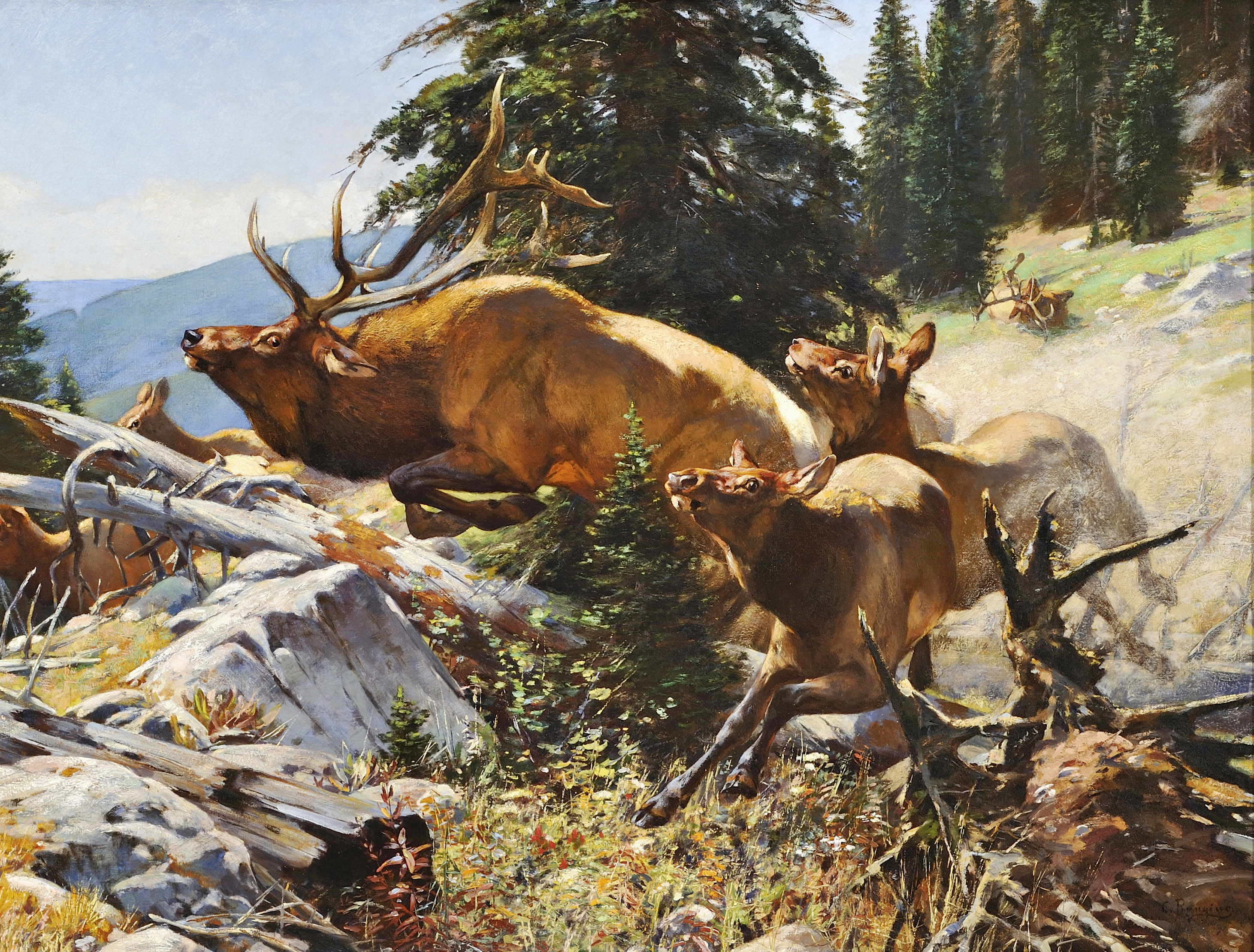
The Stampede, 1899. Carl Rungius. Oil on canvas. 26 x 46 inches. Purchased with funds generously donated by a consortium of anonymous donors, National Museum of Wildlife Art. Estate of Carl Rungius.
The Stampede is combination of drama and the artist’s lament of the trophy that got away. In the upper right corner, you can see the bull he shot along with a faint puff of rifle smoke, but the prime focal point is a startled bull and his harem racing wildly away.
Rungius excelled by bringing “dynamic symmetry” to his compositions by guiding viewers’ eyes through the action or explosion of color, Harris says. In the last half of his life, he became legendary for heroic poses of his subjects, but they were never stiff or static; his command as a colorist made them visually mellifluous.
As a boy in Europe, Rungius became smitten with the dream of one day exploring the wilds of North America after reading a German translation of James Fenimore Cooper’s Last of the Mohicans. He first came to the continent in 1894 on a moose-hunting trip in Maine with his uncle. During his visit, he met a wrangler who worked at the Box R and invited him to Wyoming.
Few people have a deeper appreciation for Rungius’ ties to Wyoming than nature painter Tucker Smith, a winner of the prestigious Prix de West Prize. For the past three decades dating to 1980, Smith has been tracing Rungius’ course into the Wind Rivers with a paint kit in his horse’s panier. Smith’s portrayal of wapiti on the National Elk Refuge, across the road from the museum, is one of the most popular in the collection.
Smith says Rungius’ animals, which possess a heft of mass and form, emanate an alluring sculptural quality.
“He was creating in two dimensions, but he was thinking in three dimensions,” Smith explains. “The magic is that he could not only portray the animal masterfully but the nature of it in general, conveying the space that it inhabited and the feeling you get of being fully immersed in the outdoors.”
Thanks to many years of thoughtful acquisition on the part of Bill and Joffa Kerr, some 52 Rungius works formed the nucleus of the collection when the museum was founded in Jackson in 1987 and, over the years, has continued growing.
One part of the sesquicentennial is called “Rungius Reunited.” As its centerpiece, it features Rungius works that had once hung together at the Bronx Zoo in New York City. Eventually, those large paintings came West and were displayed together at Jackson Lake Lodge.
Following the acquisition of private ranch lands and structures in Jackson Hole by the Rockefeller family, who then gifted those holdings to the federal government to create today’s Grand Teton National Park, a number of Rungius works were also gifted—half going to the Buffalo Bill Center of the West in Cody, Wyoming and the other half to the National Museum of Wildlife Art.
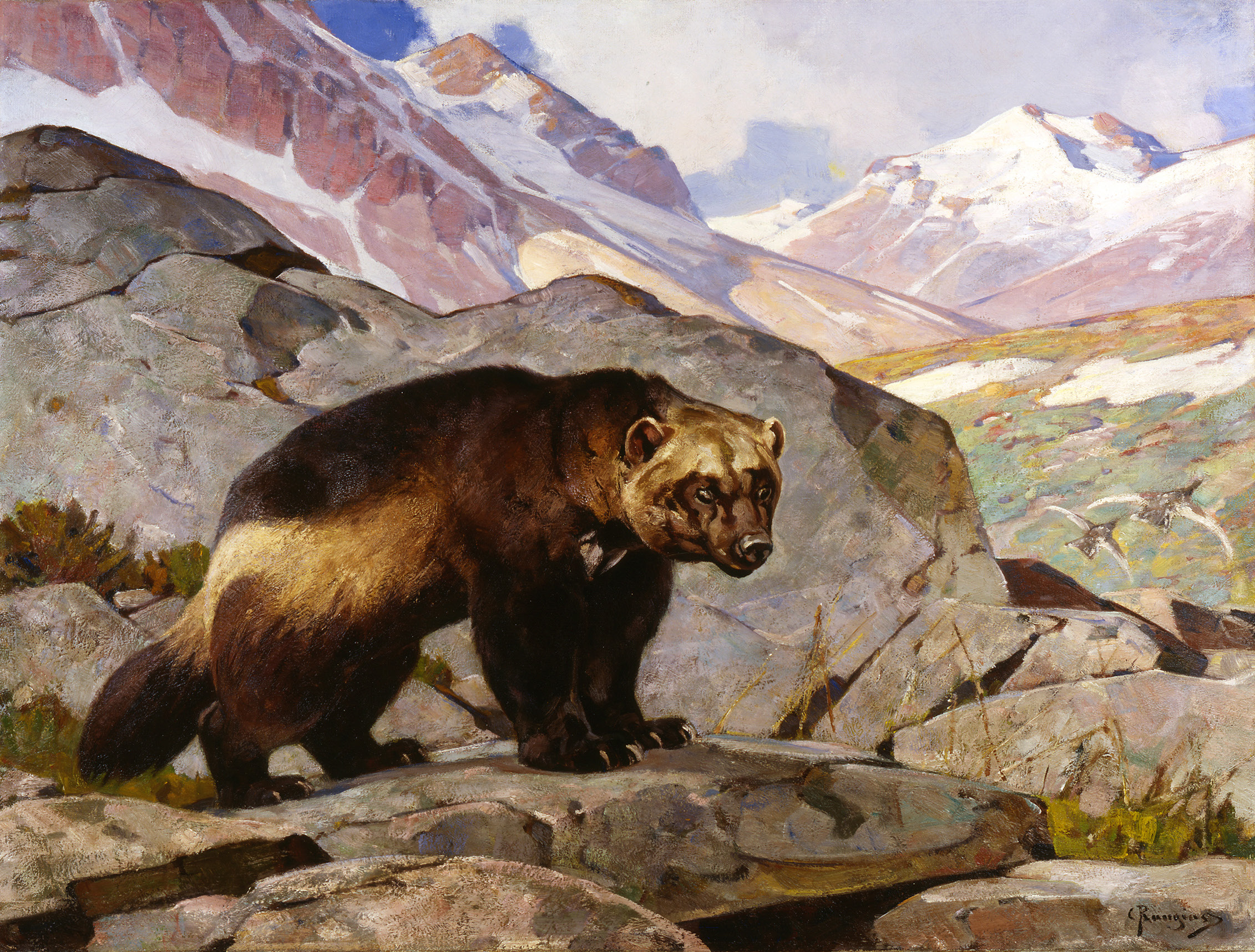
Wolverine in a Rocky Mountain Landscape, Alberta, 1919. Carl Rungius. Oil on canvas,
34 x 44 inches. Buffalo Bill Center of the West, Cody, WY. Gift of Jackson Hole Preserve, Inc. 16.93.3
Today, they have come together again for the first time in years. Rungius’ portrayals of bison, gray wolves, black bears and a smaller depiction of a red fox are mixed with paintings of bighorn sheep, mule deer, wolverine and a big silvertip grizzly from Cody.
“This is really cool,” says Harris. “It’s a great story of a journey that began in a different era when they were first displayed in New York.” The second part of the museum’s exhibition is devoted to a “Rungius Rarely Seen” section.
“With Rungius, you have authenticity,” says Tucker Smith. “He lived what he painted. He hunted some of the animals in his scenes. He camped under the stars in good weather and bad. He breathed it in. Had he wanted, he could have become known as a great Western artist or anything he wanted.”
In 1908, after encountering Rungius’ work at the Salmagundi Club in Manhattan, the eminent Frederic Remington, king of interpreting the wild West, reached out to Rungius and told him he wanted to secure a piece for his own wall. He found Rungius’ work both original and exciting. So did Teddy Roosevelt and William Temple Hornaday, director of the New York Zoological Society who featured Rungius’ paintings at the Bronx Zoo where they were viewed by the masses.
Roosevelt and Hornaday, hunters like Rungius, were conservationists who helped launch a national campaign to save the bison from extinction, who organized campaigns to create a system of federally protected areas as a gift to future generations, and who promoted a new appreciation for the origins of species.
For we hunters, seeing a collection of original Rungius’ paintings grouped together is worthy of a pilgrimage.
“When you’re talking about Rungius, it’s tough to say it adequately in words the standing and impact that’s he’s had on wildlife art,” Harris says. “His work causes us to stop and ponder our own world. Any artist that can do that is worth celebrating and remembering.”

